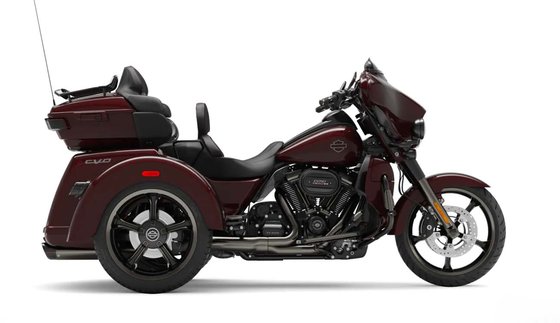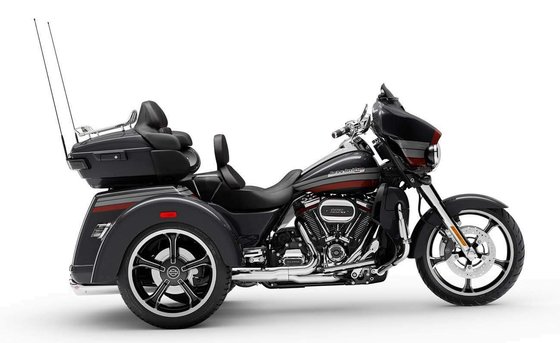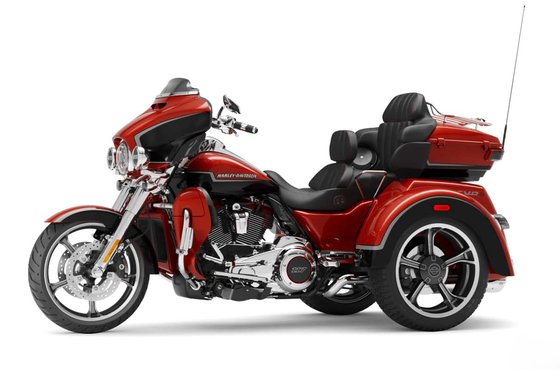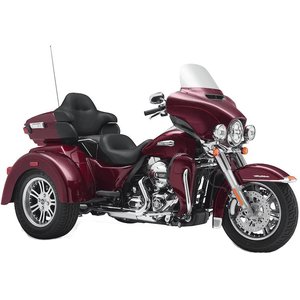Harley-Davidson Tri Glide Ultra Classic/CVO [2017-2020]: A Three-Wheeled Touring Powerhouse Review

Introduction
The Harley-Davidson Tri Glide Ultra Classic/CVO isn’t just a motorcycle—it’s a statement. Designed for riders who crave the open road but demand stability, comfort, and storage capacity, this three-wheeled touring machine redefines long-distance cruising. As part of Harley’s touring dynasty, the Tri Glide generation from 2017-2020 blends classic American V-twin muscle with trike-specific engineering. Having spent time behind its ape-hanger handlebars, I can confidently say this isn’t just a compromise for those avoiding two wheels—it’s a purpose-built touring marvel.
Design & First Impressions

The Tri Glide’s design screams “road dominance.” Its 2670-2675 mm (105.1-105.3 in) length and dual rear wheels give it a muscular stance, while the batwing fairing and integrated trunk evoke Harley’s touring pedigree. The CVO variants turn heads further with premium finishes like Black Stardust/Magnetic Gray/Wicked Red paint and Tomahawk wheels. Even base models feature thoughtful touches: front fender running lights, chrome 2-1-2 exhausts, and a 22.7-liter (6.0-gallon) fuel tank that mirrors traditional bagger proportions.
The cockpit is a masterclass in touring ergonomics. The 735 mm (28.9 in) seat height (lowered to 658 mm/25.9 in on CVO) accommodates most riders, while floorboards and heated grips (CVO standard) encourage all-day comfort. Storage? The 4.4 cubic-foot trunk swallows full-face helmets, complemented by a Tour-Pak carrier for extra luggage—a godsend for cross-country trips.
Engine & Performance
The Heart of the Beast

This generation saw significant engine evolution:
- 2017-2018: Milwaukee-Eight 107 (1,745cc/106.5 cu in) producing 90 HP and 165 Nm (121.7 lb-ft) of torque
- 2019 onward: Twin-Cooled Milwaukee-Eight 114 (1,868cc/114 cu in) with 100 HP and 169.5 Nm (125 lb-ft)
- CVO models: The crown jewel—a 1,923cc (117 cu in) monster churning out 105 HP and 170 Nm (125.5 lb-ft)
Throttle response is quintessential Harley: low-end grunt that pulls like a freight train from 3,000 RPM. The 6-speed gearbox pairs beautifully with the belt final drive, offering buttery shifts. While fuel economy varies between 5.6-6.6 L/100 km (35.6-42 mpg), the real story is the soundtrack—a bass-heavy exhaust note that’s muffled enough for highway comfort but still raw enough to announce your presence.
On the Road: Comfort & Handling

Riding a trike is a unique experience. The 1670 mm (65.7 in) wheelbase and 100 mm (3.9 in) trail provide car-like stability without sacrificing lean-friendly dynamics. At low speeds, the electric reverse gear (standard) is a back-saver in parking lots.
The suspension setup—49mm telescopic forks up front and emulsion shocks at the rear—absorbs potholes gracefully. CVO models add adjustable preload, letting you dial in stiffness for passenger/luggage loads. Cornering? Don’t expect knee-dragging, but the Tri Glide carves curves confidently, especially with ABS and linked brakes (2019+ models).
Wind management is stellar. The low-profile windshield (CVO) or standard fairing deflects buffeting, while optional heated seats and grips extend riding seasons. At 564-577 kg (1,243-1,269 lbs), it’s no featherweight, but the weight distribution hides the bulk once moving.
Competition

The Tri Glide’s main rivals are:
-
Can-Am Spyder RT:
Pros: Sportier handling, 1330cc Rotax engine, Yaw Stability Control.
Cons: Lacks Harley’s aftermarket ecosystem, smaller storage. -
Honda Gold Wing Tour DCT:
Pros: 1833cc flat-six power, superb tech (Apple CarPlay), lighter at 409 kg.
Cons: No reverse on base models, less customizable. -
Indian Roadmaster:
Pros: Thunder Stroke 116 engine, luxurious ride.
Cons: Traditional two wheels, higher seat (660 mm/26 in).
The Tri Glide wins for riders prioritizing brand heritage, customization potential, and trike-specific engineering. While the Spyder is nimbler and the Gold Wing more tech-forward, neither matches Harley’s rumble or the CVO’s premium finishes.
Maintenance & Ownership
Key Considerations:
- Oil Changes: Requires SAE 20W-50 (4.75L/5 qt with filter). CVO’s oil-cooled 117 demands strict 5,000 km (3,100 mi) intervals.
- Belt Drive: More durable than chains but inspect every 16,000 km (10k mi) for cracks.
- Brakes: Linked ABS systems (2019+) need fluid flushes every 2 years. Rear pads wear faster due to integrated parking brake.
- Tires: Unique sizes (front MT90-B16; rear 205/65-R15 or 215/45-R18 on CVO). Rotate rears every 8,000 km (5k mi).
MOTOPARTS.store Recommendations:
- Upgrade to high-flow air filters (like Arlen Ness Big Sucker) to unleash hidden torque.
- Install aftermarket exhausts (Vance & Hines Twin Slash) for improved sound without compromising emissions.
- Consider progressive suspension kits for riders carrying heavy loads.
Final Thoughts
The 2017-2020 Tri Glide Ultra Classic/CVO isn’t just a motorcycle for those “aging out” of two wheels—it’s a specialist tool for riders who value comfort, storage, and unmistakable presence. While its weight and thirst for fuel (and attention) won’t appeal to minimalists, few machines deliver mile-eating prowess with this much character. From the base model’s practicality to the CVO’s showroom shine, this trike generation proves three wheels can be just as thrilling as two—just with more room for souvenirs.
Ready to make your Tri Glide truly yours? Explore MOTOPARTS.store’s curated selection of performance upgrades, comfort accessories, and trike-specific gear to elevate your next adventure.
Specifications sheet
| Engine | |
|---|---|
| Stroke: | Four-stroke |
| Max power: | 105 kW | 141.0 hp |
| Max torque: | 170 Nm |
| Fuel system: | Electronic Sequential Port Fuel Injection (ESPFI) |
| Max power @: | 5000 rpm |
| Displacement: | 1923 ccm |
| Fuel control: | Double Overhead Cams/Twin Cam (DOHC) |
| Max torque @: | 3750 rpm |
| Bore x stroke: | 104.0 x 114.0 mm (4.1 x 4.5 in) |
| Configuration: | V |
| Cooling system: | Twin-Cooled (air/oil) |
| Compression ratio: | 10.5:1 |
| Number of cylinders: | 2 |
| Dimensions | |
|---|---|
| Wheelbase: | 1670 mm (65.7 in) |
| Dry weight: | 563 |
| Wet weight: | 577 |
| Seat height: | 658–735 mm (25.9–28.9 in) adjustable |
| Overall width: | 1395 mm (54.9 in) |
| Overall height: | 1330 mm (52.4 in) |
| Overall length: | 2675 mm (105.3 in) |
| Ground clearance: | 130 mm (5.1 in) |
| Fuel tank capacity: | 22.7 L (6.0 US gal) |
| Drivetrain | |
|---|---|
| Clutch: | Mechanically actuated 10-plate wet Assist & Slip |
| Final drive: | belt |
| Gear ratios: | 1st 10.534, 2nd 7.302, 3rd 5.423, 4th 4.392, 5th 3.741, 6th 3.157 |
| Transmission: | 6-speed |
| Primary drive: | Chain, 34/46 ratio |
| Maintenance | |
|---|---|
| Engine oil: | SAE 20W-50 |
| Brake fluid: | DOT 4 |
| Spark plugs: | NGK CR9E or NGK CR9EIX |
| Spark plug gap: | 0.8 |
| Valve clearance: | Hydraulic self-adjusting lifters (no manual adjustment required) |
| Coolant capacity: | 0.8 |
| Rear tire pressure: | 1.8 bar (26 psi) |
| Transmission fluid: | Per Harley-Davidson specifications |
| Engine oil capacity: | 4.7 |
| Front tire pressure: | 2.5 bar (36 psi) |
| Primary drive fluid: | Per Harley-Davidson specifications |
| Engine oil change interval: | Every 5,000 km or 2 years |
| Additional Features | |
|---|---|
| Comfort: | Heated grips, heated seats, cruise control, Bluetooth connectivity |
| Storage: | Locking trunk (4.4 cu ft capacity) with Tour-Pak® carrier |
| Lighting: | Full LED lighting (Daymaker Adaptive headlamp, fog lamps, signals) |
| Instruments: | Digital display with odometer, trip meters, gear indicator, fuel range, and diagnostics |
| Safety Systems: | Reflex™ Defensive Rider Systems (ABS, traction control, linked brakes) |
| Chassis and Suspension | |
|---|---|
| Rake: | 26.0° |
| Frame: | Mild steel, square-section backbone with twin downtubes |
| Trail: | 100 mm (3.94 in) |
| Rear tire: | 215/45-18 83t (dual) |
| Front tire: | 130/60b19 m/c 61h |
| Rear brakes: | Dual 270 mm discs, 1-piston floating caliper with integrated park brake (ABS) |
| Front brakes: | Double 300 mm discs, 4-piston calipers (ABS) |
| Rear suspension: | Hand-adjustable emulsion monoshock |
| Front suspension: | 49mm dual bending valve telescopic fork |
| Rear wheel travel: | 76 mm (3.0 in) |
| Front wheel travel: | 117 mm (4.6 in) |



















